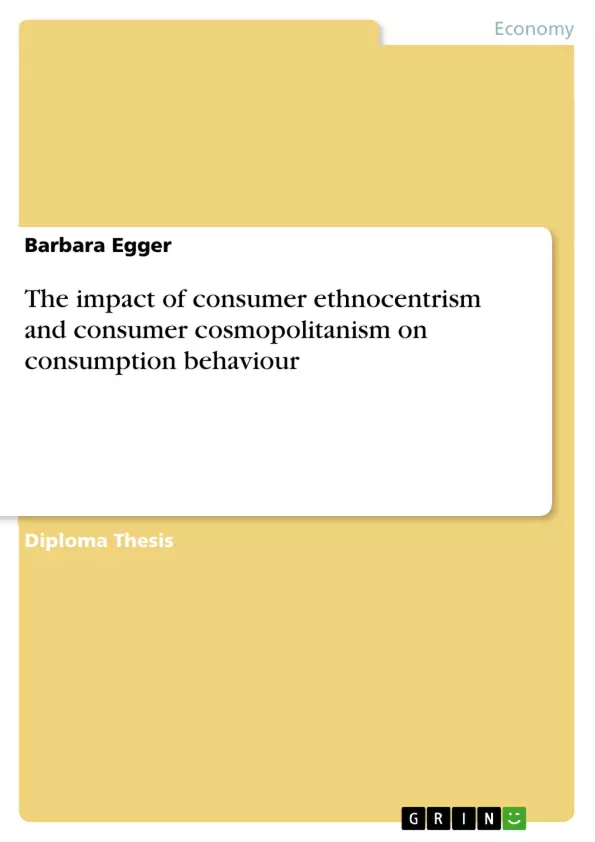This diploma thesis investigates the impact of consumer ethnocentrism and consumer cosmopolitanism on consumption behaviour. For this purpose the confirmed CETSCALE was applied however given the insufficient psychometric properties of the existing consumer cosmopolitanism scale, the need arose to develop a new measure of consumer cosmopolitanism. Accordingly, first the concept of cosmopolitanism is introduced. A cosmopolitan consumer is defined as being an open-minded individual whose consumption orientation transcends any particular culture, locality or community and who appreciates diversity including trying products and services from a variety of countries. A corresponding measure, the consumer cosmopolitanism scale, is formulated and validated. Following assessments of the scale’s structure, an extensive empirical study provides support for the consumer cosmopolitanism scale’s reliability, content and construct validity. A series of nomological validity tests show consumer cosmopolitanism to be moderately predictive of theoretically related constructs. Managerial implications of these findings are considered and future research directions are identified.
Table of Contents
- I. Introduction.
- II. A literature review of consumer ethnocentrism
- II.1. The concept of consumer ethnocentrism
- II.1.1. Ethnocentrism
- II.1.2. Consumer ethnocentrism
- II.1.3. Related constructs
- II.2. The measurement of consumer ethnocentrism: the CETSCALE
- II.2.1. Construction of the CETSCALE
- II.2.2. Psychometric properties
- II.2.3. Cross-national assessment of the CETSCALE
- II.2.4. The impact of consumer ethnocentrism on buying behaviour
- II.2.5. Antecedents of consumer ethnocentrism
- III. A literature review of consumer cosmopolitanism
- III.1. The concept of cosmopolitanism
- III.1.1. Definitions of cosmopolitanism
- III.1.2. Conceptualizations of cosmopolitanism
- III.1.3. Related concepts
- III.2. The measurement of cosmopolitanism
- III.3. The concept of consumer cosmopolitanism
- III.3.1. Cosmopolitanism and consumer behaviour
- III.3.2. Definitions of consumer cosmopolitanism
- III.3.3. Conceptualization of consumer cosmopolitanism
- III.4. The measurement of consumer cosmopolitanism: the CYMYC scale
- III.4.1. Empirical studies on consumer cosmopolitanism
- III.4.2. The need for a new scale
- III.5. Summary of findings
- IV. The new consumer cosmopolitanism scale
- IV.1. Scale development
Objectives and Key Themes
This diploma thesis investigates the impact of consumer ethnocentrism and consumer cosmopolitanism on consumption behavior. The main goal of this work is to explore the relationship between these two concepts and consumer behavior, with a particular focus on developing a new measure of consumer cosmopolitanism. Key themes explored in the text include:- Consumer ethnocentrism and its influence on purchasing decisions
- Consumer cosmopolitanism as a contrasting concept to ethnocentrism
- The development and validation of a new consumer cosmopolitanism scale
- The theoretical and managerial implications of the findings
- Future research directions in the field of consumer cosmopolitanism
Chapter Summaries
- Chapter I: Introduction This chapter provides an overview of the research topic and outlines the purpose and objectives of the diploma thesis. The author introduces the concepts of consumer ethnocentrism and consumer cosmopolitanism and highlights the significance of their impact on consumption behavior.
- Chapter II: A Literature Review of Consumer Ethnocentrism This chapter presents a comprehensive review of the existing literature on consumer ethnocentrism. It examines the concept of ethnocentrism, its application to consumer behavior, and explores related constructs. The chapter further analyzes the CETSCALE, a widely used measure of consumer ethnocentrism, examining its construction, psychometric properties, and cross-national assessment. It concludes by discussing the impact of consumer ethnocentrism on buying behavior and its antecedents.
- Chapter III: A Literature Review of Consumer Cosmopolitanism This chapter delves into the concept of consumer cosmopolitanism, providing a comprehensive literature review. It examines various definitions and conceptualizations of cosmopolitanism, as well as its relationship to consumer behavior. The author analyzes the existing measurement instruments for cosmopolitanism and highlights the need for a new scale specifically tailored to consumer cosmopolitanism. The chapter concludes with a summary of the findings and outlines the rationale for developing a new consumer cosmopolitanism scale.
Keywords
This diploma thesis focuses on the key concepts of consumer ethnocentrism and consumer cosmopolitanism. It explores the theoretical frameworks and empirical evidence related to these constructs, their impact on consumption behavior, and the development of a new measurement scale for consumer cosmopolitanism. The main keywords include consumer behavior, ethnocentrism, cosmopolitanism, CETSCALE, CYMYC scale, and psychometric properties.- Quote paper
- Barbara Egger (Author), 2006, The impact of consumer ethnocentrism and consumer cosmopolitanism on consumption behaviour, Munich, GRIN Verlag, https://www.grin.com/document/112000



